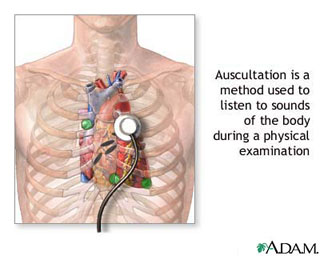Auscultation (lung) - Heart and Breath Sounds

Auscultation Definition
Auscultation is the diagnostic procedure of listening to the LUNGS using a STETHOSCOPE held to various placements on the chest and back. Auscultation allows the doctor to hear normal and abnormal BREATH SOUNDS, the noises of air flowing through the respiratory tract. The doctor typically listens to the same location for each lung, to compare the sounds, and moves in a side-to-side pattern first across the chest from the apex to base (top to bottom) of each lung and then a similar pattern on the back. When conducting a pulmonary examination, the doctor also listens with the stethoscope placed over the TRACHEA at the throat.
Auscultation Heart and Breath Sounds
There are four normal breath sounds-tracheal, vesicular, bronchial, and bronchovesicular-all heard upon both inhalation and exhalation. Deviations in tone, loudness, frequency, and character of the sounds help the doctor assess the performance of the lungs. Extra sounds, such as rales and wheezes, are abnormal and signal pulmonary ailments such as BRONCHITIS, ASTHMA, and PNEUMONIA. The doctor usually listens to the HEART as well during auscultation, as the HEART SOUNDS provide additional diagnostic information. The doctor uses the diaphragm of the stethoscope to auscultate for breath sounds and the bell of the stethoscope to auscultate for heart sounds.
See also APNEA; BREATHING; DYSPNEA; TACHYPNEA.